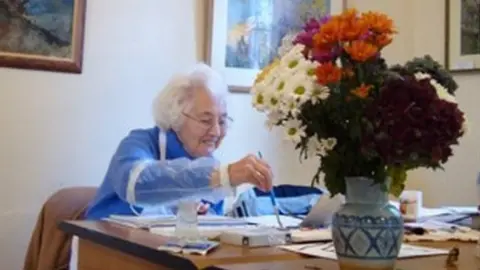The power of paint: Watercolours for dementia
 Sheila Austin
Sheila AustinLiving with Alzheimer's disease might seem to many like a bleak and isolating existence.
But for Pat Rayfield, of Wrexham, the last 11 years living with the condition turned into some of her most creative.
Encouraged by her husband of 70 years, John, she began to paint. At first it was just a few watercolours - still lifes of flowers and everyday objects, often copied from books and magazines.
But then, as her talent and confidence grew, she tried more diverse themes, including landscapes and wildlife, and a handful of abstract paintings.
Family favourites include one of fireworks exploding on bonfire night, and another of a meerkat.
Pat's daughter, Sheila, from Cardiff, said: "In her youth, mum dabbled with oil painting, but then didn't pick up her brushes consistently until she was 85.
"I took her on a weekend watercolour course to give dad some respite, and it took off from there."
 Sheila Austin
Sheila AustinAs Pat's Alzheimer's took hold, she gradually began forgetting the processes of how to dress and cook - something which she had always loved.
It was a steep deterioration for a woman who had always been bright and cheerful, a keen church goer and the lynch pin of the family home, raising her five children; Ann, Sheila, Alison, Paul and Mark.
But the family firmly believes that taking up watercolours helped their mother with her deteriorating memory loss.
Sheila, 69, said: "You could tell that when she was painting she was happy and relaxed.
"She was in the moment, enjoying herself, not anxious or worrying about anything.
"It didn't matter that she couldn't remember it afterwards. She enjoyed it at the time."
The painting became particularly important when Pat moved into a nursing home in 2015.
 Sheila Austin
Sheila AustinSheila said: "Sometimes you visit nursing homes and you see old people lined up in chairs, nodding off to sleep with a TV blaring in the corner.
"It's very sad, but we learnt that if you take the time and trouble, a person's quality of life can be greatly improved.
"Dad, in particular, refused to let dementia define mum.
"He sought out activities she could enjoy, unrestricted by the perceived barriers which many falsely believe dementia can impose.
"There are plenty of creative activities people can enjoy which don't rely heavily on memory and we would encourage others who have relatives in similar positions to help them access them."
For Pat, her love of painting continued into her final days.
Her last painting, a vibrant riotous canvas of autumnal colours, was completed in December 2016, and she died three months later in March 2017, aged 93.
After she died, her children collected her 200 paintings together and had them framed.
 Sheila Austin
Sheila AustinThis Saturday, they are putting on an exhibition of the work, selling some of the pictures to raise money for Dementia Friendly Wrexham, which works to overcome discrimination against those with the disease.
The charity's chairwoman, Norah Lucas said Pat's paintings were a "positive proof" that a dementia diagnosis did not mean an end to that person's accomplishments.
She said: "Pat's husband, John, realised before many of us that we must not let misconceptions about dementia deny people an opportunity to explore new outlets.
"His approach to the condition was to work with it rather than let it overwhelm you. He realised this instinctively even before groups like ours were established."
The Pat Rayfield exhibition will be at Regent Street Methodist Church, Wrexham, on Saturday April 14, from 10:30 BST.
